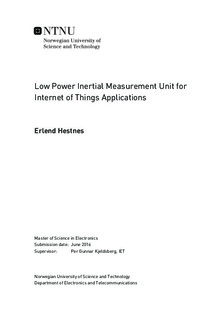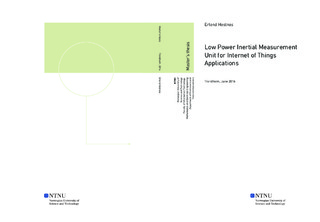| dc.description.abstract | Motion sensing is an interesting area for Internet of Things (IoT) applications. Today, motion sensing for embedded applications is usually achieved by using an inertial measurement unit (IMU). An IMU is a sensor package, which normally consists of an accelerometer, gyroscope and sometimes a magnetometer. The introduction of micro-electromechanical systems (MEMS) has enabled IMUs to undergo miniaturization as well as significant cost reduction. There is however still an inherent problem with power consumption for these devices. While both accelerometers and magnetometers are able to operate in the microampere range, gyroscopes usually require a few milliamperes. Several publications have showed that it is possible to create a Gyro-Free IMU (GF-IMU) by using a combination of multiple accelerometers placed in a special cube configuration.
Most of the accelerometer based GF-IMU solutions that exists are impractical due to the amount of sensors used and the size of the cube. The practical implementation of a GF-IMU based on two tri-axial accelerometers is relatively new. As such, there are many open questions regarding its true potential.
Both a simulation-based approach and a practical implementation have been used to investigate an existing GF-IMU solution based on two tri-axial accelerometers named EcoIMU. The simulation has been used for a theoretical analysis to better illustrate the relationship between different cube geometries and the parameters of precision and power consumption. The practical implementation has been used to provide actual data on how a GF-IMU compares to a conventional gyro-based IMU.
The simulation has successfully been used to show the relationship between different cube configurations and the parameters of precision and power consumption in a GF-IMU. The results from the practical testbed implementation has shown that it is possible to use a GF-IMU configuration to provide an estimate of angular velocity with an average mean squared error (MSE) of 64.68. The angular velocity estimate can further be used to provide an angle of rotation with an accuracy of +-10 degrees over a short period of time. At best, the implemented GF-IMU consumes 79.6% less current than a conventional gyro-based IMU. The testbed results have also revealed a severe limitation with the EcoIMU implementation. Namely, that there is hidden dependency in the equations used for calculating rotation about each axis. This dependency makes it impossible to calculate the angular velocity about the X, Y and Z-axis at the same time.
From the acquired results, we have concluded that the area of applications between the implemented GF-IMU and a conventional gyro-based IMU are different. While a conventional IMU is precise enough to be used for inertial navigation applications, a GF-IMU can only be accurate over a short period of time. A GF-IMU is therefore more suited for applications that only require simple trajectory estimation, such as gesture detection and attitude estimation. | |

